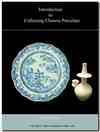Novice Collector Tips
Things Novice Collectors of Chinese Porcelain Must Know
Age
This page is the result of a good number of porcelain identification requests received every week through this website.
Clearly, many of these queries concern age, value, where made, etc., but
it is also evident that many beginning collectors need the
information have little knowledge how genuine antique porcelain looks
like in view to age, prior to buying.
Collectors new to Chinese porcelain are in a predicament. Judging the
age as we would with other antiques doesn't work when it comes to
porcelain.
Many are surprised when they discover that their old-looking piece is
only vintage or even new. I know ...I've been there, as were most
collectors!
| Tip: Novice collectors should not start their collecting experience with monochrome porcelain. Monochrome porcelain is more difficult to authenticate. With Yongzheng monochromes, for example, it is difficult to keep genuine and fake antiques apart, even when you have experience. Start with blue and white or other polychrome porcelain instead. The colors or color tones and the decoration/patterns on polychrome porcelain can provide valuable clues regarding authenticity. With monochromes you have only that single color. |
For the benefit of novice collectors without any
experience, I list here some essential points you must get adapted
to, with examples from the site's gallery. Please also check the pages
about porcelain age signs.
First it is necessary to clarify something that all
collectors with many years of collecting experience know. Chances
that you find any expensive Ming or Qing ceramics at a thrift store,
flea market, etc. is about as remote as winning the lottery.
So, if you have found some Chinese porcelain in such a place, please don't expect it to be valuable.
Mostly the items that can
be found in such places are vintage at the best, or recently made.
Finding something made in the 19th century is nice, from the first half
of the 19th century or even earlier would be exceptional. Often the Chinese
items found in such places are made within the last two or three
decades. Many are factory made or otherwise mass produced.
Another thing novice collectors must learn to accept is that
porcelain that looks old is not necessarily so. In fact, there are
vintage items that look older than porcelain items made over 200 years
ago.
Please check these examples of 18th century porcelain from the gallery:
- The antique items shown on this page are relatively common export porcelain dishes and plates dating to the Qianlong reign (1736-1795).
- The second example is a Qing dynasty porcelain plate dating to the Yongzheng reign (1723-1735).
- This is a blue and white dish from the Kangxi reign (1662-1722).
New or old?
Many of the wars made for the common people during the early 20th
century are of lesser quality and sometimes look outright old in
comparison to genuine antiques made, for example, in the 18th century. Sometimes this is even the case with vintage porcelain
that is only a few decades old. There may be a difference in production quality, and their glaze may contain sand or other impurities, giving them an old (or
"rustic") look, but actually they are just of low quality.
Even in the
distal past the glaze of porcelain made for the common people rarely
would have been contaminated with sand or other impurities on the
outside surface. Sand may be present around the foot rhyme, depending on
the firing method used by some of the early kilns.
Please learn to differentiate between this superficial "old-look" and real age signs. See page related to age signs of porcelain.
If you are just starting out, always keep in mind that an old one
look does not necessarily equal old "age". And, an old look is easy
faked. See age faking.
Summarizing the issue:
- An "old" look does not necessarily mean an item is antique.
- Antique porcelain can be looking "new", but may actually be over 200 years old.
- Dirt or damage are often used to make ceramics look old, beware ...
Novice collectors should avoid spending a lot on very old
looking items at the beginning before they are able to recognize the
real porcelain age signs. Better spend your money on books and visits to the
porcelain collections of museums.
If you have an opportunity to learn with hands-on experience,
grab it! Nothing teaches you faster and is less expensive than an
experienced teacher who knows this all already. Those of us who study
porcelain on our own all had to pay our tuition fees *** (as the Chinese call it), just be careful not to pay too much. The trial and error method of
leaning can be costly and slow, sometimes.
*** At the beginning we all bought old looking items and
later learned they were only
looking that way ,. The cost of such fakes
is our tuition.
From Novice Collector to Antique Chinese Porcelain Home Page
Identifying Antiques
Tips on Antique Marks
Essential Information for Novice Collectors:
Read about the "unimportance" of marks in view o the identification and dating of Chinese porcelain
Marks info for the Novice
Mark comparison (East and West)
 Ebook Introduction to Chinese Porcelain |
